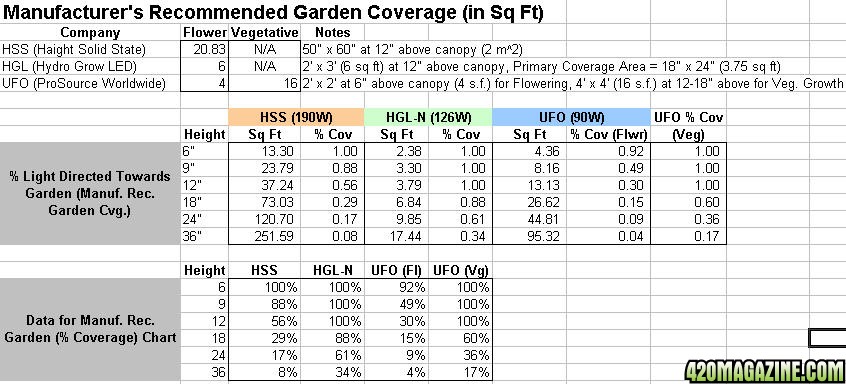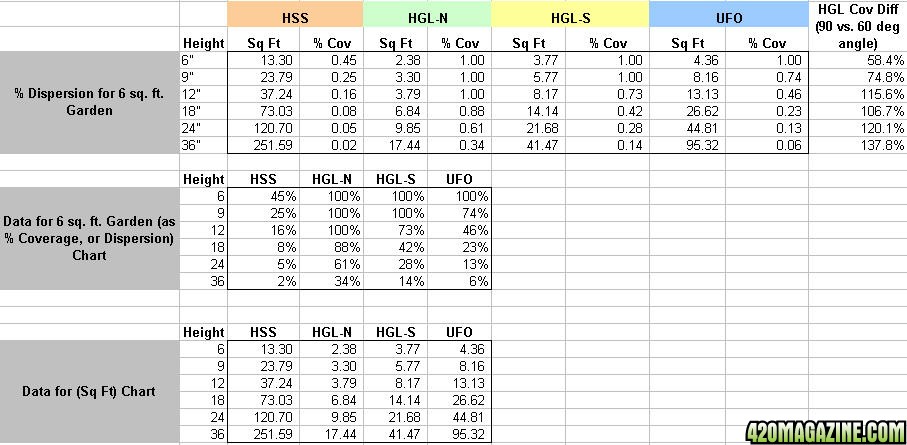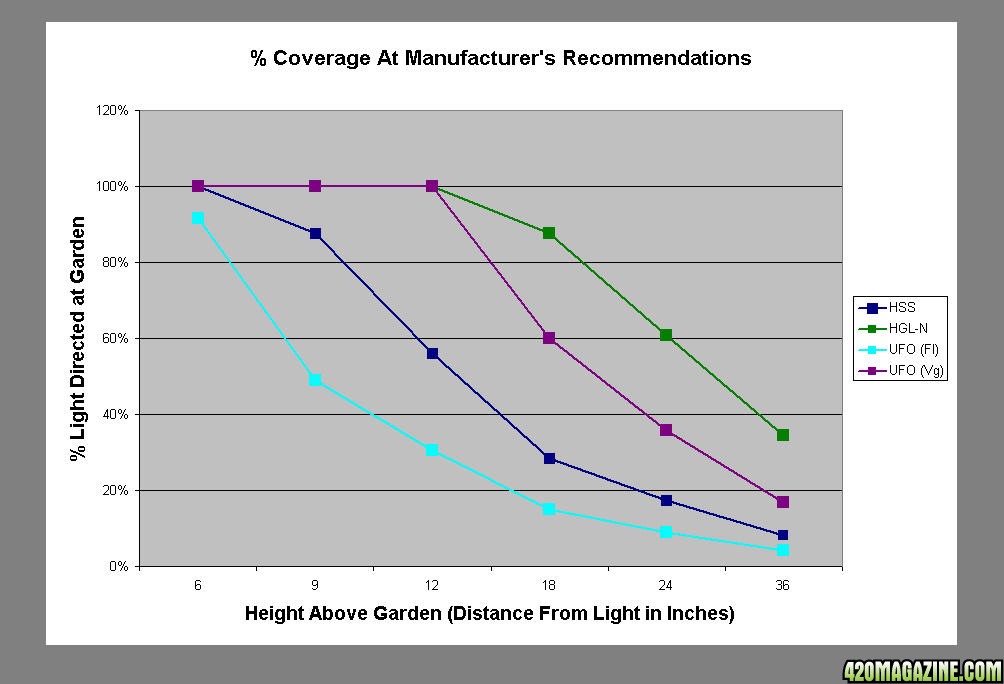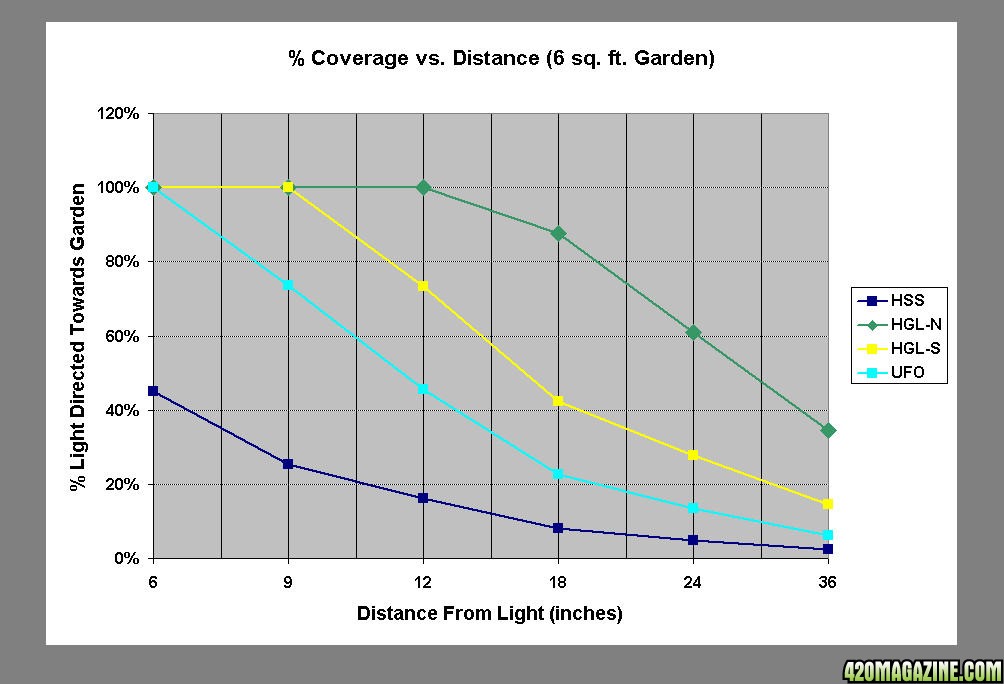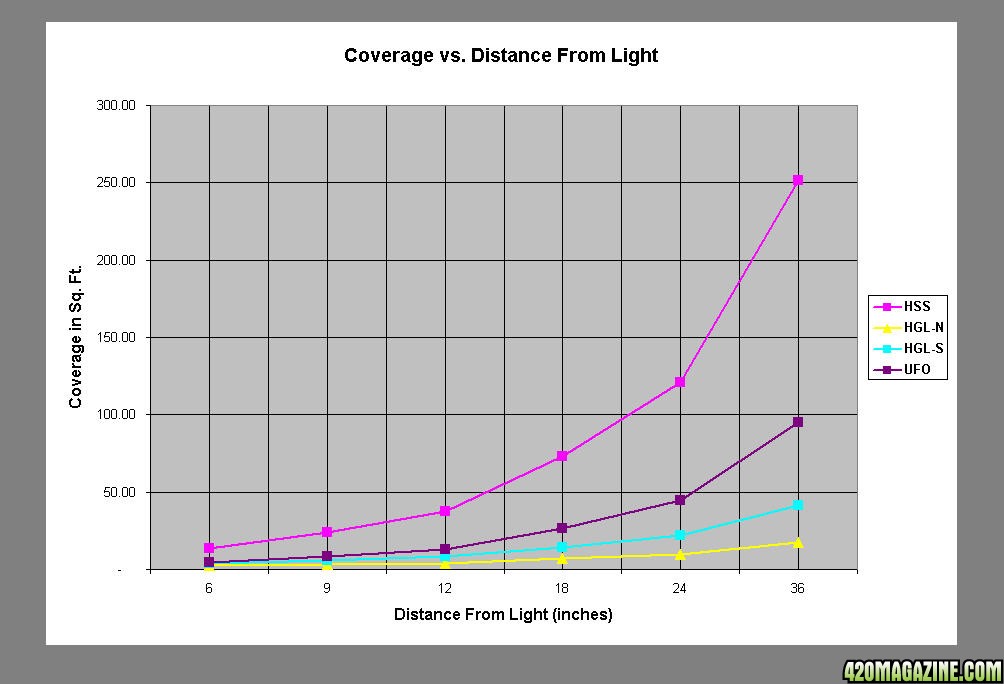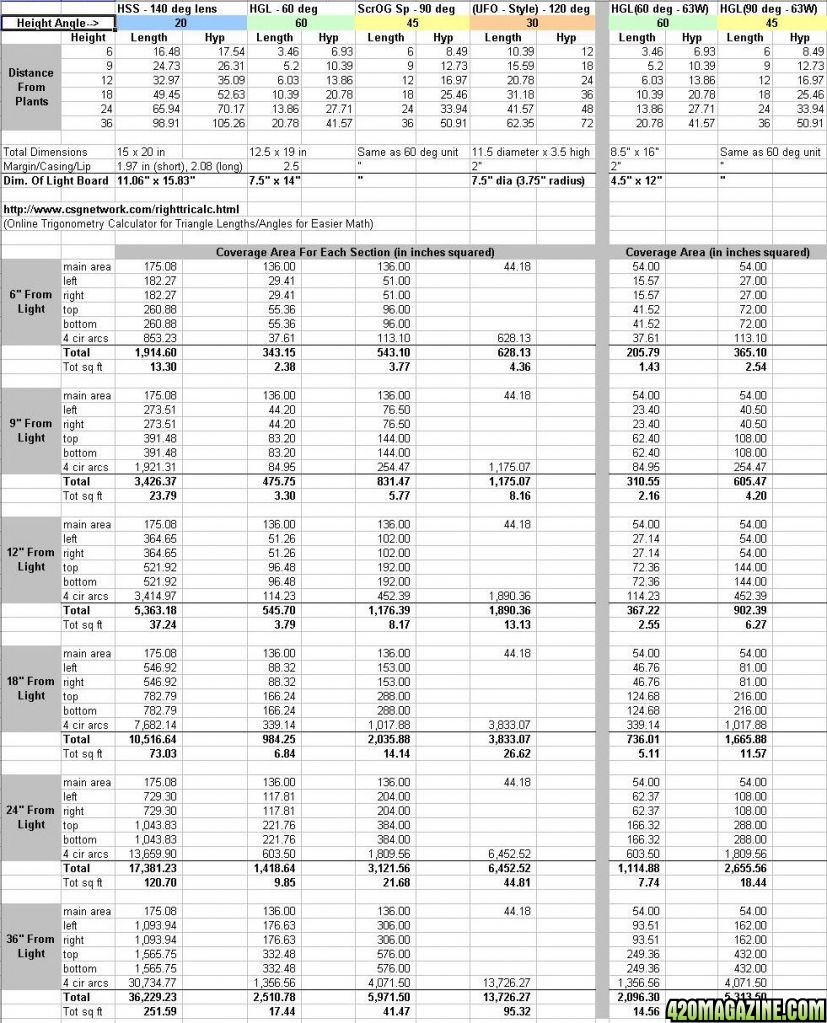The Lurker
New Member
Hey folks,
Here are some of my notes on LEDs compiled over the past few months, distilled into a more formalized format. All information contained is to the best of my knowledge, using an generally empirical (scientific) foundation while retaining a subjective (and hopefully reasoned) viewpoint, and is in all cases IMHO and should not be considered 'definitive' by any means. I may refer back to this occasionally for reference purposes in other posts and add/modify to this as required, as new information presents itself, or as my opinion and outlook changes – enjoy!
LED Light Intensity, Angle, and Dispersion
LED Light intensity, and its behavior over distance, varies from that of typical single point source lights in a couple of key areas.
• A LED is a pseudo point source close to the lens, but mimics a true point source light farther out (at a distance ~5x+ the diameter of the lens. Practically speaking, this means that even as close as ~4-6"+ from the light (i.e. the near distance for LEDs before bleaching becomes a factor), being able to treat each LED emitter as a separate point source in their illumination behavior (based on distance, etc.) is already 'true'
• The luminous intensity vs. a point source at the same distance is higher by a factor depending on the lens angle. A point source spreads light evenly over the area of a 360 degree sphere; the(LED) lens will direct it into a smaller area based on the spherical cap, like so:
Math Forum: Ask Dr. Math FAQ: Sphere Formulas
Spherical Cap -- from Wolfram MathWorld
Mensuration
And when comparing LEDs, the (initial) difference in intensity at any given distance is the ratio of the spherical cap area for any given angle (60, 120, etc.) vs. the area of an entire sphere (or part thereof, if comparing comparable LEDs with different viewing angles), based on the radius.
You can calculate a rough output like so:
The LED FAQ Pages (see Q#23)
LEDs with Punch! (bottom of page)
Based on that, one can also infer that for each LED (using the same wattage and luminous efficacy ,etc.), a 60 degree lens has ~4x the intensity of a 120 degree lens at the same distance, and ~2.25x the intensity of a 90 degree lens, for any given radius r from the lens.
That's one reason why the narrow angle LED units appear to perform much better than the wider angle units at the same height - you'll cover a smaller area, but at much higher concentrations, directly under the light. There will always be a tradeoff between intensity and coverage area (for all artificial light, and indoors); LED is no exception here.
So at greater distances the inverse square law still proves largely accurate for LEDs:
Inverse-square law - Wikipedia, the free encyclopedia
Inverse Square Law
You're simply starting out with a higher luminous flux based on the initial angle as per the above, and dropping it ~ 1/r^2 from there (vs. a point source with a true 360 degree spread at the same wattage and intensity.)
With any LED fixture, you also have multiple individual sources of light arranged in a pattern; as you get farther away from the lamp, you'll get additional cross-coverage from adjacent lights, so the drop-off in distance is somewhat mitigated by additional coverage from more LEDs within the range (distance from the light) at which such blending generally occurs.
In practice, mapping out the actual intensity on a ~3" x 3" grid at various heights based on the actual readings is much more practical in any event, and will give one a better idea of coverage also, for any particular fixture.
Estimating Coverage and Spread
In estimating how much area a fixture will cover, one needs to look at a few primary criteria:
1) Profile of the light board (i.e. the area of the fixture that houses the LED emitters, not including the outer casing or margin). Footprint and spread depends on the shape also (whether rectangular, square, or circular (UFO models))
2) Viewing angle of the lens. A 120 degree angle lens will have a downward angle (angle B; see below) of 60 degrees to each side. (One can use this to calculate the length and outer edges of the projected light at various heights above the canopy.)
3) Height above the canopy (to top of garden, most times)
4) Dispersion (how much light falls outside the garden area at each distance from the light)
(Note: Actual intensity will vary from % dispersion as this (rough estimation method) has more to do with the dispersion (area, or scattering, of the light), not intensity per se. In practice, actual intensity will be higher directly under the light due to proximity to more LEDs, and less intense further out (actual measurements in luminous flux are always better). However, there is a direct correlation between light directed straight at the canopy, and real intensity. In all cases, having as much light shining directly on the canopy is preferable to having to recover indirect lighting from reflection, and additional attrition of intensity due to material absorption/loss as heat. In other words - the more light that can be directed straight at the garden, the better.)
Most LED lights today fall into two general profiles: 1) Rectangular Base, and 2) Round Base. Using basic trigonometry, one can get a rough idea of coverage and dispersion based on 1-3, above.
With a Round Base (UFO) fixture, optimal coverage is a round garden profile, which spreads out from the light board in a circle.
With a Rectangular base (HGL, HSS, Lumigrow, GrowLED, etc.) fixture, one can estimate coverage using the light board (area directly under the light) + adding four rectangles and four circle arcs (~90 deg.) to account for coverage and dispersion to all sides based on the height and lens angle, like so:
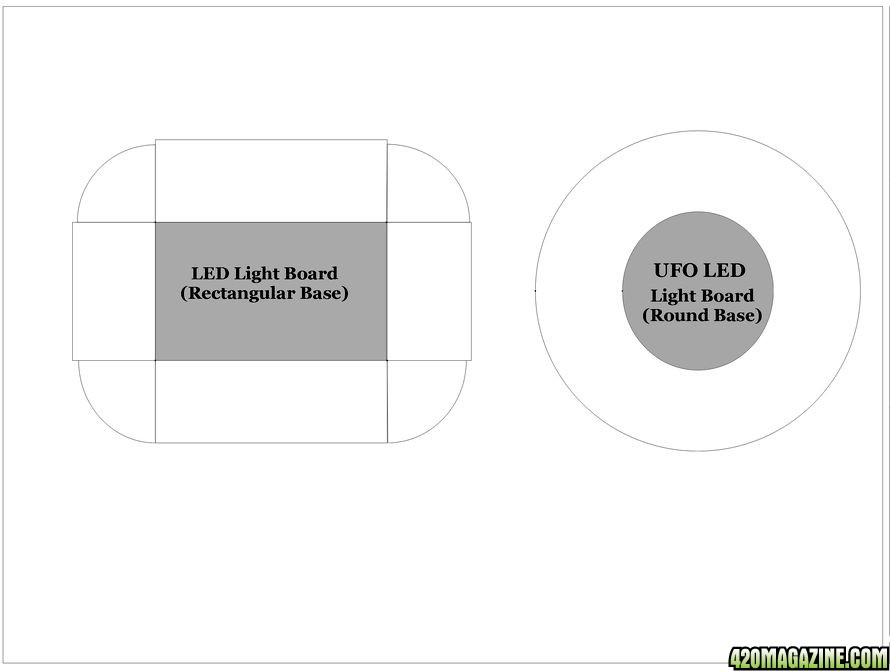
(Note: Drawing not to scale.)
I've put these numbers into a spreadsheet with a few examples; a quick way to do this yourself with a light of your choice is with an online calculator like this one:
Right Triangle Angle And Side Calculator
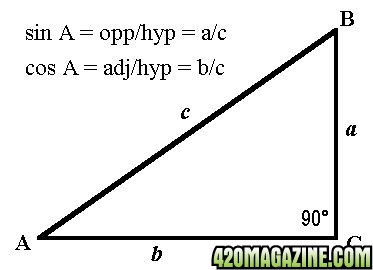
In this case:
Angle B = the LED lens (viewing) angle, divided by 2;
Side b = the Run (i.e. the horizontal garden distance that falls away from the edges of the light board). This is used in conjunction with the light board dimensions to calculate the approximate garden coverage sq. ft.
Angle A = 180 degrees minus Angle B minus 90 degrees;
Side a = Height of the LED light above the garden (or floor, etc.)
Angle C = 90 degrees (Right Triangle). A constant useful for calculating the unknown sides or angles you're solving for; and
Side c = the Hypotenuse (direct line of sight distance from the light board edge to the garden edge (under direct/primary lighting).
(Note: while the Hydro Grow units aren't a perfect rectangle (the four corners are unused with their rounded 'cluster' LED pattern), you can still use this method to get a rough estimate of the primary coverage area, just know that the actual will be slightly less than calculated. But as rough estimates, these are fine – 'good enough for government work' so to speak. To get anything more precise, best to measure the actual luminosity in any event, as mentioned above).
Using the above methods, I've put together some estimates for a couple of models I've been looking at. One can translate this to other models (Lumigrow, TI Smartlamp, etc.) as well with some basic information.
Most of it is self-explanatory; a few abbreviations I used for the units are as follows:
HSS = Haight Solid State (190W Unit) with 140 degree angles
HGL-N = Hydro Grow LED (126W Unit with a standard 60 degree angle. The 'N' stands for 'Normal')
HGL-S = HGL 126W unit with a custom 90 degree angle. This is what I'd term a 'ScrOG Special – i.e. perfect for ScrOG or low SOG style gardens.)
UFO = ProSource or knockoff 90W Unit with standard 120 degree angles
When coverage for the charts or graphs = 1.0 (100%), that simply means that all of the light angled from the fixture falls inside that particular garden sq. ft. area – whether for a manufacturer's recommended coverage area, or any particular comparison number. In this case, the example I used was 6 sq. ft. (So if the spread at 12" was less than 6 sf for a fixture, that would show up as 100% coverage. When the dispersion at a particular height goes above that, the percentage or ratio drops accordingly.)
One can see just how much even a 10-15 degree difference in lens angle has on the actual coverage/dispersion and LED intensity – and why tighter angle lenses penetrate much further (deeper) than their wide angle counterparts. After running the #'s and comparing them side-by-side, this ended up reinforcing my initial assumptions on what would be best for my own gardens also.
The Future of Lighting, and LEDs: Notes and Addenda
(Note: Numbers in parenthesis ( ) are referenced in the appendix, below.)
The Carnegie Mellon/Green Design Institute lighting technology study (1) published in March 2009 pointed out that in comparing (then current) data from incandescents, CFLs, and LEDs (at 30 lumens/watt), both the Production Energy and Use Energy requirements already gave LED a slight advantage over CFL, yielding a greener footprint over the total lifecycle of the lamp. So, the costs to both make and use LED is already cheaper than comparable tech. And following an expected (subsequent) doubling of the l/w efficiency (and given their current lifespan), LED is hands down the better choice environmentally. It also pointed out that LEDs are currently in a continuous improvement cycle in terms of efficiency; we will see 150 lumens/watt (and higher) before diminishing returns from R&D in lighting begins to flatten out the improvement curve.
The timeframe, and current estimates for reaching ~150 l/w efficiencies with LED, is only ~3-5 years away. In fact, we have already seen new products entering the market in the 60-70 lumens/watt range less than a year after the CM study came out. With regards to plant lighting, HGL is slated to release their 'Pro' models by Q2 2010, using 50%+ greater l/w output than their current models. This places their output firmly in the 60 l/w range. I'm sure other manufacturers will be following suit.
One only has to see where the R&D is being directed to find out where the market for lighting (industrial, commercial (including agriculture), and residential) will reside going forward. LED sales last year were about $2 billion worldwide; this is less than 3% of global spending currently allocated to lighting needs (2). Philips Lighting accounted for nearly half of that ($1 Billion) in LED sales (about 10% of their current total sales for lighting). Their CEO estimates sales of LEDs will reach about 80% of Philips Lighting's total sales by 2020 (with a total LED market of ~$95 billion), and 5% of their R&D is going to LED. And Siemens Osram, GE, Samsung, Sharp, Cree, and others are following suit. In other words, the industry is betting heavily on the technology in the long term.
Incandescents are being phased out legislatively worldwide as we speak, and in the US by 2012+ (Phase-out of incandescent light bulbs - Wikipedia, the free encyclopedia). CFL efficiencies aren't going to get much better going forward; any improvements are already built into the technology, for all practical purposes. HIDs are 70's era tech, and will eventually be superseded. Sulfur Plasma lighting is several years away from becoming practical and cost-effective - the magnetron remains expensive, much of the radiance is still produced at wavelengths not well utilized by plants (like traditional HIDs), and we will see little improvement in terms of lumens/watt efficiency from current levels (~140 l/w).
While I've been using HIDs since the early 90s, I'm not a big fan of single point source lighting in general. While HPS puts out a shitload (3) of lumens, most of it isn't generated at the right spectrums (i.e. PAR watts), a substantial amount of energy is lost to heat or reflection (esp. in horizontal gardens), and the light drops off too quickly away from the lamp. And even if sulfur plasma improves on lumen output and costs come down, that coverage profile is still based on a single source whose intensity falls off rapidly with distance. That means inconsistent coverage in the garden, and marginal light quality at the edges. That also makes it difficult to get decent g/watt-hr yields using higher watt units in larger gardens. And unless you're strictly gardening outside, growing a tall tree isn't very practical for indoor gardening under artificial lighting of any type. Pretty, but rather wasteful.
Current LED Grow Light Designs
Current LED units all seem to be trying to duplicate an inefficient model (derived from older, single point source tech) of cramming as much lighting into a small space as possible – perhaps more from practical reasons based on current light board designs, and the fact that many folks will be retrofitting HIDs and are used to using that profile (a single concentrated source producing all the light for an area), than from actual restrictions of the technology.
While fairly decent results may be achieved with LEDs using current profile light boards and narrow angle lenses, a more efficient design would be to spread the light out evenly over the entire area, providing uniform distribution and more consistent coverage. In effect, this light would have a profile akin to something like a fluorescent T5 HO strip light, using LEDs instead – allowing for better penetration of the canopy also. There are already retrofit (drop-in) 15W LED units designed to replace conventional T8 32W 4 foot fluorescent tubes; we now simply need to see fixtures with higher watt LEDs and more efficient spectrums (with tighter lens spreads) for grow lighting enter the market.
Optimal efficiency in a horizontal footprint using LEDs will, in all likelihood, be best realized with multi-shelf (pH's Multi-Shelf Garden Setup) setups, using a ScrOG or low profile SOG format. However, in order for them to benefit from this, it may require a number of growers to potentially change their methodology, and some may be naturally resistant in general to such change – even with the promise of better yielding gardens as a result. This reluctance is one barrier to more widespread user adoption, one which will begin to disappear once empirical evidence of repeatable results using these methods becomes evident (and with the advent of better LED designs entering the market).
Appendix:
(1) This study, available as a PDF, can be found here: (https://apps1.eere.energy.gov/buildings/publications/pdfs/ssl/matthews_chicago09.pdf)
(2) Source: Business Week, November 30, 2009: A Brighter Idea From Philips (pp. 65, 70)
(3) A Shitload: According to a reliable source from MIT's Engineering department, 'A Shitload' is a technical term for a quantitative unit of measurement that falls somewhere between 'A Lot' and 'A F**kload'. While not exactly finite, A Shitload is still considered to be quite substantial…
Here are some of my notes on LEDs compiled over the past few months, distilled into a more formalized format. All information contained is to the best of my knowledge, using an generally empirical (scientific) foundation while retaining a subjective (and hopefully reasoned) viewpoint, and is in all cases IMHO and should not be considered 'definitive' by any means. I may refer back to this occasionally for reference purposes in other posts and add/modify to this as required, as new information presents itself, or as my opinion and outlook changes – enjoy!
LED Light Intensity, Angle, and Dispersion
LED Light intensity, and its behavior over distance, varies from that of typical single point source lights in a couple of key areas.
• A LED is a pseudo point source close to the lens, but mimics a true point source light farther out (at a distance ~5x+ the diameter of the lens. Practically speaking, this means that even as close as ~4-6"+ from the light (i.e. the near distance for LEDs before bleaching becomes a factor), being able to treat each LED emitter as a separate point source in their illumination behavior (based on distance, etc.) is already 'true'
• The luminous intensity vs. a point source at the same distance is higher by a factor depending on the lens angle. A point source spreads light evenly over the area of a 360 degree sphere; the(LED) lens will direct it into a smaller area based on the spherical cap, like so:
Math Forum: Ask Dr. Math FAQ: Sphere Formulas
Spherical Cap -- from Wolfram MathWorld
Mensuration
And when comparing LEDs, the (initial) difference in intensity at any given distance is the ratio of the spherical cap area for any given angle (60, 120, etc.) vs. the area of an entire sphere (or part thereof, if comparing comparable LEDs with different viewing angles), based on the radius.
You can calculate a rough output like so:
The LED FAQ Pages (see Q#23)
LEDs with Punch! (bottom of page)
Based on that, one can also infer that for each LED (using the same wattage and luminous efficacy ,etc.), a 60 degree lens has ~4x the intensity of a 120 degree lens at the same distance, and ~2.25x the intensity of a 90 degree lens, for any given radius r from the lens.
That's one reason why the narrow angle LED units appear to perform much better than the wider angle units at the same height - you'll cover a smaller area, but at much higher concentrations, directly under the light. There will always be a tradeoff between intensity and coverage area (for all artificial light, and indoors); LED is no exception here.
So at greater distances the inverse square law still proves largely accurate for LEDs:
Inverse-square law - Wikipedia, the free encyclopedia
Inverse Square Law
You're simply starting out with a higher luminous flux based on the initial angle as per the above, and dropping it ~ 1/r^2 from there (vs. a point source with a true 360 degree spread at the same wattage and intensity.)
With any LED fixture, you also have multiple individual sources of light arranged in a pattern; as you get farther away from the lamp, you'll get additional cross-coverage from adjacent lights, so the drop-off in distance is somewhat mitigated by additional coverage from more LEDs within the range (distance from the light) at which such blending generally occurs.
In practice, mapping out the actual intensity on a ~3" x 3" grid at various heights based on the actual readings is much more practical in any event, and will give one a better idea of coverage also, for any particular fixture.
Estimating Coverage and Spread
In estimating how much area a fixture will cover, one needs to look at a few primary criteria:
1) Profile of the light board (i.e. the area of the fixture that houses the LED emitters, not including the outer casing or margin). Footprint and spread depends on the shape also (whether rectangular, square, or circular (UFO models))
2) Viewing angle of the lens. A 120 degree angle lens will have a downward angle (angle B; see below) of 60 degrees to each side. (One can use this to calculate the length and outer edges of the projected light at various heights above the canopy.)
3) Height above the canopy (to top of garden, most times)
4) Dispersion (how much light falls outside the garden area at each distance from the light)
(Note: Actual intensity will vary from % dispersion as this (rough estimation method) has more to do with the dispersion (area, or scattering, of the light), not intensity per se. In practice, actual intensity will be higher directly under the light due to proximity to more LEDs, and less intense further out (actual measurements in luminous flux are always better). However, there is a direct correlation between light directed straight at the canopy, and real intensity. In all cases, having as much light shining directly on the canopy is preferable to having to recover indirect lighting from reflection, and additional attrition of intensity due to material absorption/loss as heat. In other words - the more light that can be directed straight at the garden, the better.)
Most LED lights today fall into two general profiles: 1) Rectangular Base, and 2) Round Base. Using basic trigonometry, one can get a rough idea of coverage and dispersion based on 1-3, above.
With a Round Base (UFO) fixture, optimal coverage is a round garden profile, which spreads out from the light board in a circle.
With a Rectangular base (HGL, HSS, Lumigrow, GrowLED, etc.) fixture, one can estimate coverage using the light board (area directly under the light) + adding four rectangles and four circle arcs (~90 deg.) to account for coverage and dispersion to all sides based on the height and lens angle, like so:

(Note: Drawing not to scale.)
I've put these numbers into a spreadsheet with a few examples; a quick way to do this yourself with a light of your choice is with an online calculator like this one:
Right Triangle Angle And Side Calculator

In this case:
Angle B = the LED lens (viewing) angle, divided by 2;
Side b = the Run (i.e. the horizontal garden distance that falls away from the edges of the light board). This is used in conjunction with the light board dimensions to calculate the approximate garden coverage sq. ft.
Angle A = 180 degrees minus Angle B minus 90 degrees;
Side a = Height of the LED light above the garden (or floor, etc.)
Angle C = 90 degrees (Right Triangle). A constant useful for calculating the unknown sides or angles you're solving for; and
Side c = the Hypotenuse (direct line of sight distance from the light board edge to the garden edge (under direct/primary lighting).
(Note: while the Hydro Grow units aren't a perfect rectangle (the four corners are unused with their rounded 'cluster' LED pattern), you can still use this method to get a rough estimate of the primary coverage area, just know that the actual will be slightly less than calculated. But as rough estimates, these are fine – 'good enough for government work' so to speak. To get anything more precise, best to measure the actual luminosity in any event, as mentioned above).
Using the above methods, I've put together some estimates for a couple of models I've been looking at. One can translate this to other models (Lumigrow, TI Smartlamp, etc.) as well with some basic information.
Most of it is self-explanatory; a few abbreviations I used for the units are as follows:
HSS = Haight Solid State (190W Unit) with 140 degree angles
HGL-N = Hydro Grow LED (126W Unit with a standard 60 degree angle. The 'N' stands for 'Normal')
HGL-S = HGL 126W unit with a custom 90 degree angle. This is what I'd term a 'ScrOG Special – i.e. perfect for ScrOG or low SOG style gardens.)
UFO = ProSource or knockoff 90W Unit with standard 120 degree angles
When coverage for the charts or graphs = 1.0 (100%), that simply means that all of the light angled from the fixture falls inside that particular garden sq. ft. area – whether for a manufacturer's recommended coverage area, or any particular comparison number. In this case, the example I used was 6 sq. ft. (So if the spread at 12" was less than 6 sf for a fixture, that would show up as 100% coverage. When the dispersion at a particular height goes above that, the percentage or ratio drops accordingly.)
One can see just how much even a 10-15 degree difference in lens angle has on the actual coverage/dispersion and LED intensity – and why tighter angle lenses penetrate much further (deeper) than their wide angle counterparts. After running the #'s and comparing them side-by-side, this ended up reinforcing my initial assumptions on what would be best for my own gardens also.
The Future of Lighting, and LEDs: Notes and Addenda
(Note: Numbers in parenthesis ( ) are referenced in the appendix, below.)
The Carnegie Mellon/Green Design Institute lighting technology study (1) published in March 2009 pointed out that in comparing (then current) data from incandescents, CFLs, and LEDs (at 30 lumens/watt), both the Production Energy and Use Energy requirements already gave LED a slight advantage over CFL, yielding a greener footprint over the total lifecycle of the lamp. So, the costs to both make and use LED is already cheaper than comparable tech. And following an expected (subsequent) doubling of the l/w efficiency (and given their current lifespan), LED is hands down the better choice environmentally. It also pointed out that LEDs are currently in a continuous improvement cycle in terms of efficiency; we will see 150 lumens/watt (and higher) before diminishing returns from R&D in lighting begins to flatten out the improvement curve.
The timeframe, and current estimates for reaching ~150 l/w efficiencies with LED, is only ~3-5 years away. In fact, we have already seen new products entering the market in the 60-70 lumens/watt range less than a year after the CM study came out. With regards to plant lighting, HGL is slated to release their 'Pro' models by Q2 2010, using 50%+ greater l/w output than their current models. This places their output firmly in the 60 l/w range. I'm sure other manufacturers will be following suit.
One only has to see where the R&D is being directed to find out where the market for lighting (industrial, commercial (including agriculture), and residential) will reside going forward. LED sales last year were about $2 billion worldwide; this is less than 3% of global spending currently allocated to lighting needs (2). Philips Lighting accounted for nearly half of that ($1 Billion) in LED sales (about 10% of their current total sales for lighting). Their CEO estimates sales of LEDs will reach about 80% of Philips Lighting's total sales by 2020 (with a total LED market of ~$95 billion), and 5% of their R&D is going to LED. And Siemens Osram, GE, Samsung, Sharp, Cree, and others are following suit. In other words, the industry is betting heavily on the technology in the long term.
Incandescents are being phased out legislatively worldwide as we speak, and in the US by 2012+ (Phase-out of incandescent light bulbs - Wikipedia, the free encyclopedia). CFL efficiencies aren't going to get much better going forward; any improvements are already built into the technology, for all practical purposes. HIDs are 70's era tech, and will eventually be superseded. Sulfur Plasma lighting is several years away from becoming practical and cost-effective - the magnetron remains expensive, much of the radiance is still produced at wavelengths not well utilized by plants (like traditional HIDs), and we will see little improvement in terms of lumens/watt efficiency from current levels (~140 l/w).
While I've been using HIDs since the early 90s, I'm not a big fan of single point source lighting in general. While HPS puts out a shitload (3) of lumens, most of it isn't generated at the right spectrums (i.e. PAR watts), a substantial amount of energy is lost to heat or reflection (esp. in horizontal gardens), and the light drops off too quickly away from the lamp. And even if sulfur plasma improves on lumen output and costs come down, that coverage profile is still based on a single source whose intensity falls off rapidly with distance. That means inconsistent coverage in the garden, and marginal light quality at the edges. That also makes it difficult to get decent g/watt-hr yields using higher watt units in larger gardens. And unless you're strictly gardening outside, growing a tall tree isn't very practical for indoor gardening under artificial lighting of any type. Pretty, but rather wasteful.
Current LED Grow Light Designs
Current LED units all seem to be trying to duplicate an inefficient model (derived from older, single point source tech) of cramming as much lighting into a small space as possible – perhaps more from practical reasons based on current light board designs, and the fact that many folks will be retrofitting HIDs and are used to using that profile (a single concentrated source producing all the light for an area), than from actual restrictions of the technology.
While fairly decent results may be achieved with LEDs using current profile light boards and narrow angle lenses, a more efficient design would be to spread the light out evenly over the entire area, providing uniform distribution and more consistent coverage. In effect, this light would have a profile akin to something like a fluorescent T5 HO strip light, using LEDs instead – allowing for better penetration of the canopy also. There are already retrofit (drop-in) 15W LED units designed to replace conventional T8 32W 4 foot fluorescent tubes; we now simply need to see fixtures with higher watt LEDs and more efficient spectrums (with tighter lens spreads) for grow lighting enter the market.
Optimal efficiency in a horizontal footprint using LEDs will, in all likelihood, be best realized with multi-shelf (pH's Multi-Shelf Garden Setup) setups, using a ScrOG or low profile SOG format. However, in order for them to benefit from this, it may require a number of growers to potentially change their methodology, and some may be naturally resistant in general to such change – even with the promise of better yielding gardens as a result. This reluctance is one barrier to more widespread user adoption, one which will begin to disappear once empirical evidence of repeatable results using these methods becomes evident (and with the advent of better LED designs entering the market).
Appendix:
(1) This study, available as a PDF, can be found here: (https://apps1.eere.energy.gov/buildings/publications/pdfs/ssl/matthews_chicago09.pdf)
(2) Source: Business Week, November 30, 2009: A Brighter Idea From Philips (pp. 65, 70)
(3) A Shitload: According to a reliable source from MIT's Engineering department, 'A Shitload' is a technical term for a quantitative unit of measurement that falls somewhere between 'A Lot' and 'A F**kload'. While not exactly finite, A Shitload is still considered to be quite substantial…



